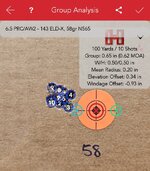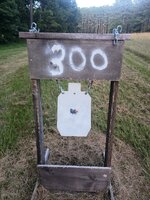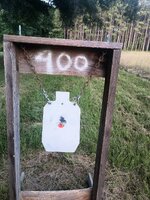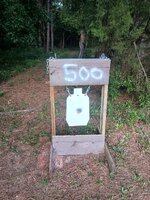Haha, thank you! That was her first elk (she drew a good tag), and she earned it! Open sight black powder muzzleloader hunt of a lifetime.
Dispersion is linear so I don't do anything past 100 yards for load testing. The problem with testing all those powder charge iterations is the variability built into the sample size. So I absolutely agree that if you test 68.7, 68.9, 69.1, 69.3, it will probably produce a group that's noticeably better than the others. The problem is, it's not repeatable. If you were to keep pumping rounds into those groups at those powder charges, the tightest group would open up and the largest group would fill in, and the end result of the 2 groups would be the same, +/- X% depending on sample size. SOMETIMES the higher powder charges produce more dispersion, that is known and stated by ballisticians. But the same variability goes for seating depth, I started a thread years back called "Does seating depth even matter?", and after 8 or so pages there wasn't one single piece of valid evidence that someone "tuned" the seating depth to get less dispersion out of a load.
I mean do it how you do it, how you explained in your reply. 600 yards, 68.7, 68.9, seating depth test, etc. The point is to compare the hodge podge easy method group to your fully developed group at the end with somewhat valid sample sizes and see if you actually made an improvement. After doing this multiple times in a variety of calibers, I have not been able to, nor have I seen valid proof of anyone else doing so either without switching a component.
The Painless Load Dev/Hornady method. I load .040-.050" off the lands (most of my chambers are spec'd for a certain bullet weight to be that far off with the boat tail edge seated to the neck shoulder junction), or mag length and I shoot a pressure ladder 1 shot each in .5gr increments starting 1-2gr below avg published book max up to 1gr above and look for pressure. I'll drop at least 1gr from signs like ejector marks, and 2gr from bolt lift to stay out of trouble if I get moisture on a case while hunting or something. Then I shoot a 10 shot group, 2 strings of 5 shots cooling in between. My goal is for it to be under 1". If it does that, I'm done. If it's over 1.2", I swap bullet or powder, and repeat. Typically I will switch powder first, I've seen dispersion cut in half by different powders. But sometimes a barrel doesn't like a bullet and I'd rather have a good temp stable powder than a certain bullet. If I go through 2 reputable powders and 2-3 bullets without getting an acceptable result, I chalk that one up as a loss and will replace the barrel.
To add more to the intent of the thread, I like to test in warm weather. If it's super hot I may do another quick pressure ladder later and see if it's safe to bump the charge up a bit in more moderate weather. Also I'm sure you know but it's worth noting that if you go full tilt on new brass and are loaded right up to the edge of pressure, it will likely show up after brass is formed. Expect to drop the charge after 1st firing, as I explained in my previous comment.
Here's the result of that exact process. I tested H1000 and N565 using that process. The H1000 group opened up a bit toward the end (could have been mirage, could have been me), but the N565 group had plenty good velocity and grouped like this.
View attachment 891960




